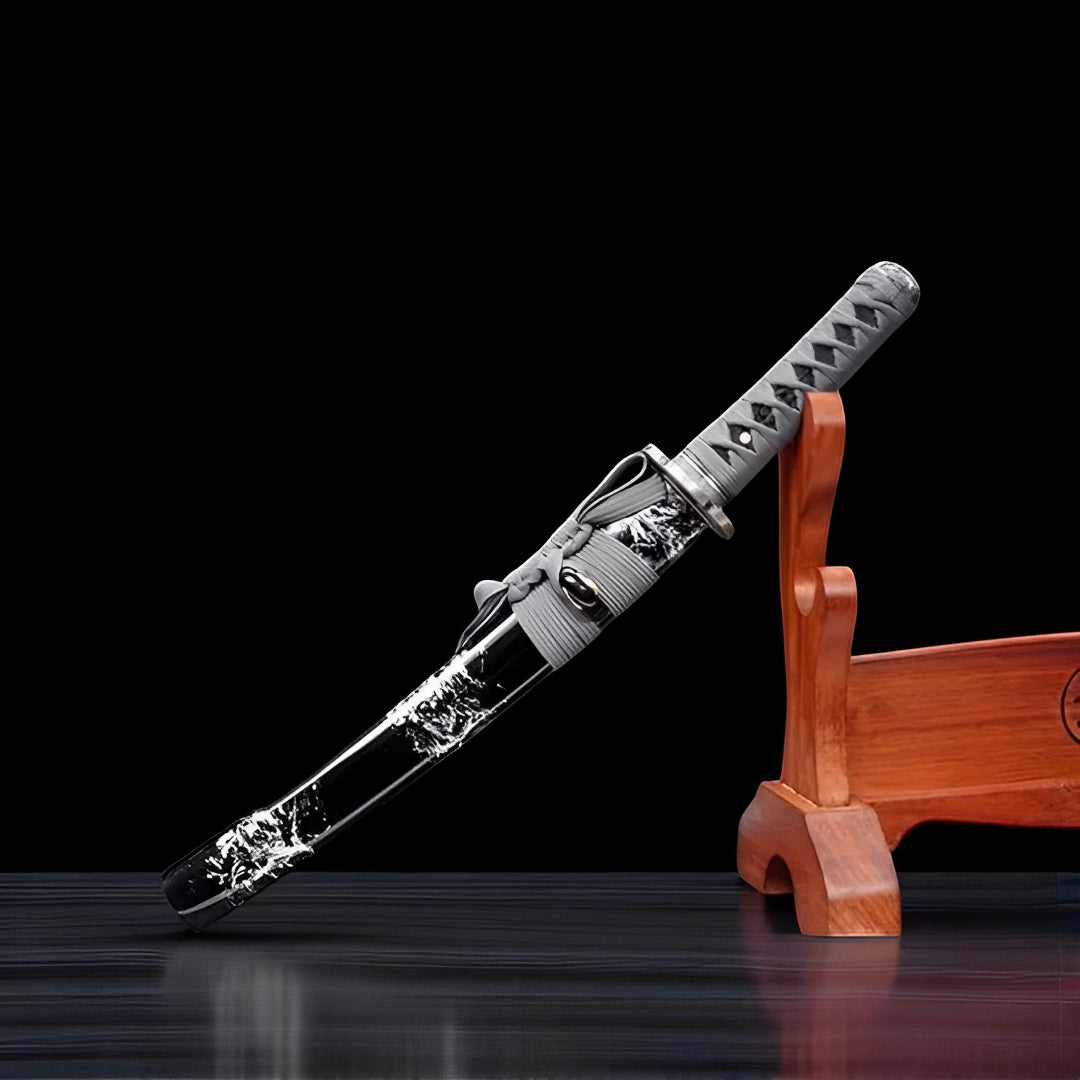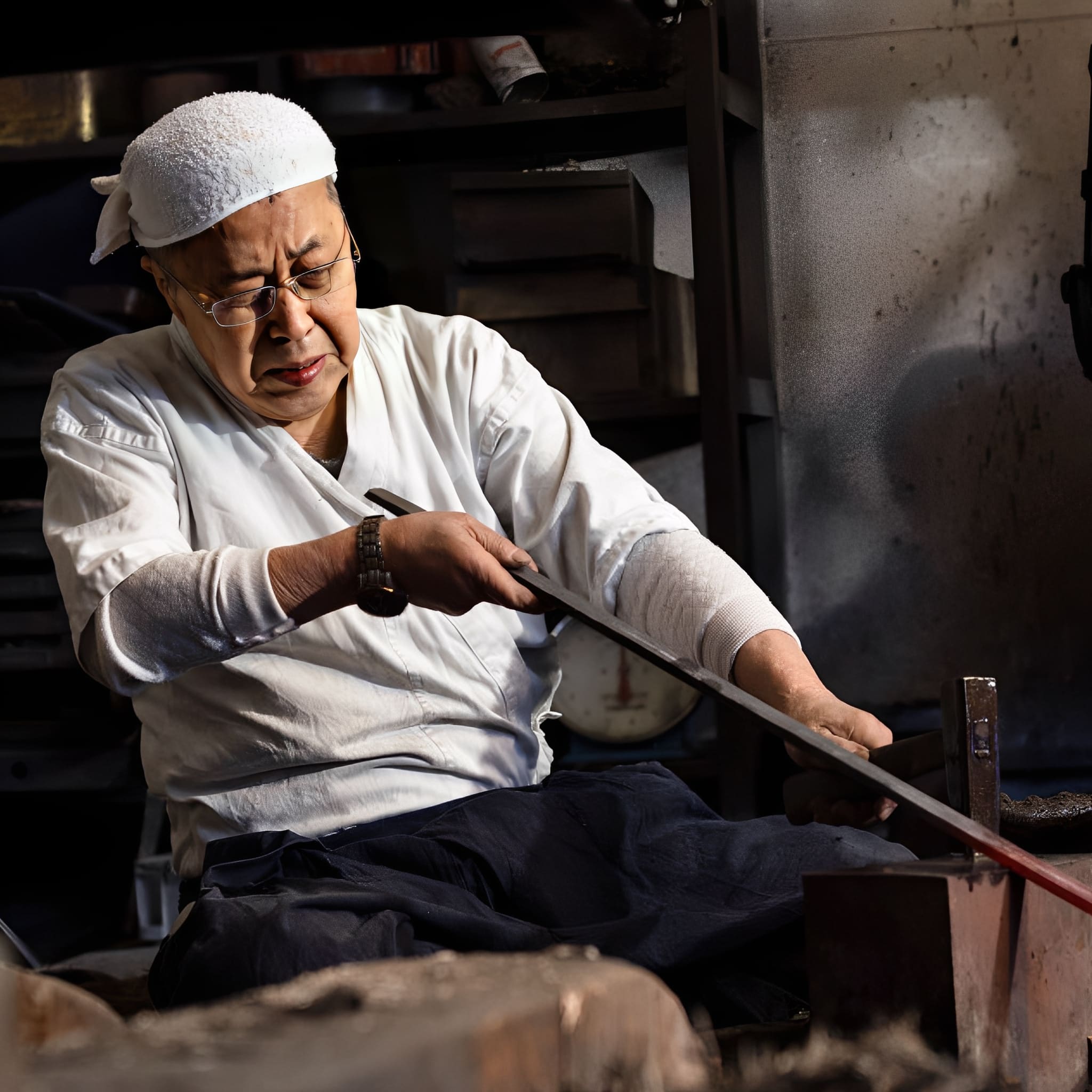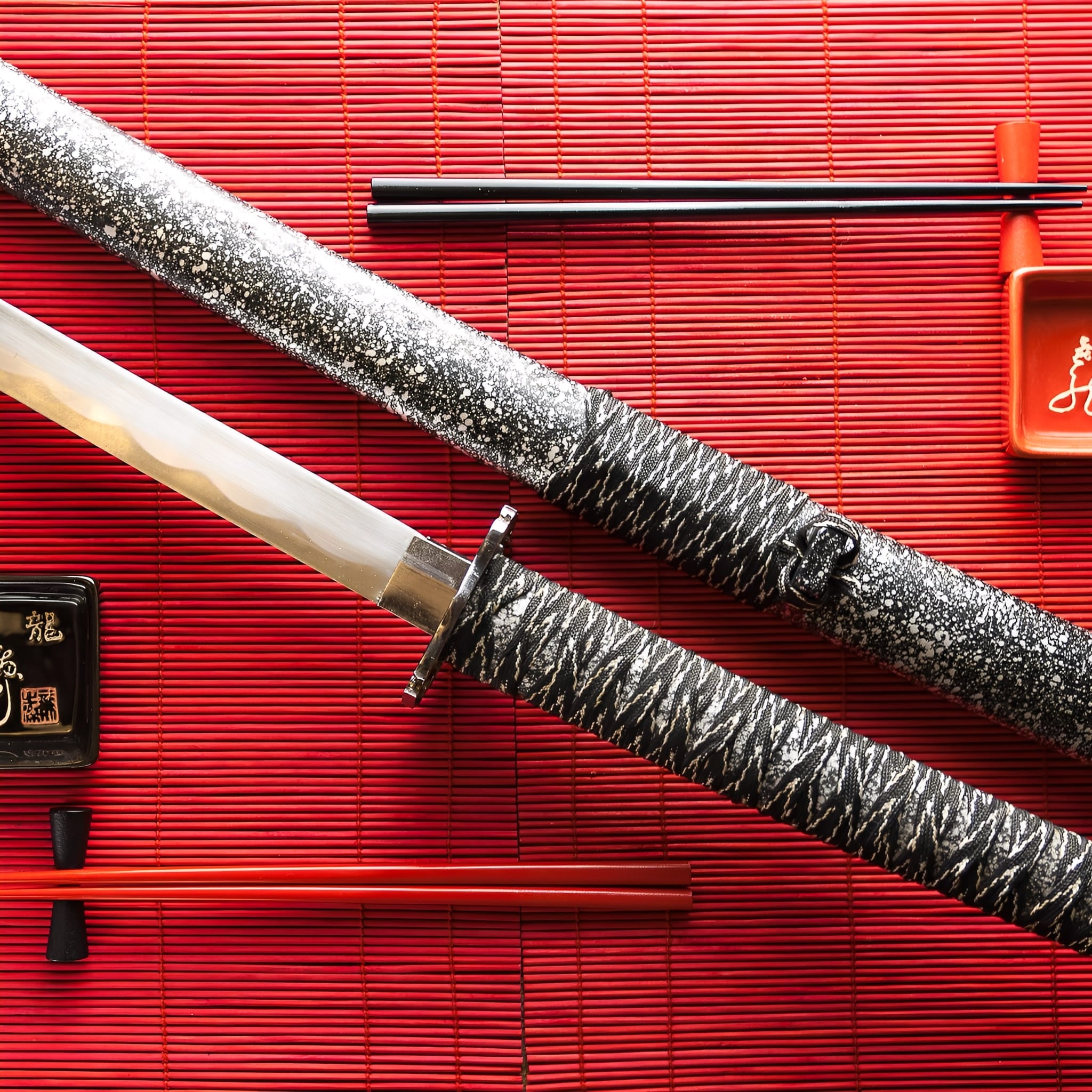Refund Guaranteed

Why choose us
Ships within 48/72h
Forged Blade
Collector Quality
Trusted Globally
Inspired by Japan
Byakuen Tanto (T10 Steel) - 白炎短
Popular upgrades
Free Shipping over $250
No Bots, No AI
Refund Guaranteed
Free Shipping over $250
No Bots, No AI
Our team is here to help with any questions or concerns.
We’re always happy to assist you — don’t hesitate to reach out.
Why choose us
Ships within 48/72h
Forged Blade
Collector Quality
Trusted Globally
Inspired by Japan

Byakuen Tanto (T10 Steel) - 白炎短
Specifications
- Handcrafted
- SHARP blade
- Blade: T10 steel
- Habaki made of brass
- Synthetic ray skin on the tsuka
- Kojiri & Kashira made of iron
- Solid wood saya
- Full tang in the handle
- Total length: 50 cm
- Blade length: 33 cm
- Blade width: 3.2 cm
- Blade thickness: 0.7 cm
-
Handle length: 16 cm
Byakuen Tanto - White Tiger Illustrated Blade
Witness artistry unleashed with the Byakuen Tanto, where master illustrators transform glossy black saya into narrative canvas. This striking Japanese short sword features intricate white engravings depicting mythological beasts locked in eternal struggle - possibly Byakko the White Tiger battling demons or dragons, rendered with detail rivaling museum scroll paintings. When weaponry becomes gallery piece, collectors face beautiful dilemma: display or possess?
Narrative Engraving Art
The defining glory of this illustrated tanto lies in its saya's elaborate white artwork wrapping around the scabbard's length. Unlike simple patterns or minimal symbols, this design tells stories through densely packed imagery requiring minutes of examination to fully appreciate all compositional layers.
The primary figure appears to be a magnificent white tiger or mythological beast - possibly Byakko (白虎), the White Tiger of the West, one of four legendary guardians in Asian cosmology. This celestial creature commanded autumn, controlled metal elements, and protected against evil spirits. Warriors invoking Byakko sought his attributes: raw courage, overwhelming force, predator's precision.
The tiger/beast engages with surrounding elements - perhaps battling serpentine dragons, confronting demons, or asserting dominance over lesser creatures. Traditional Japanese art frequently depicted such confrontations as metaphors for internal struggles between duty and desire, order and chaos, civilization and wild nature.
Supporting characters and environmental details fill every available space - swirling clouds suggest heavenly realms, flame patterns indicate supernatural power, decorative flourishes frame the action. This horror vacui (fear of empty space) approach creates visual richness where discovering new details rewards each viewing session.
The white-on-black color scheme maximizes contrast, making every line pop with clarity despite the composition's complexity. This monochrome choice also references sumi-e ink painting and woodblock print traditions where masters demonstrated that single color contains infinite expressive potential.
Monochrome Masterpiece
Black and white represent ultimate contrast - day versus night, presence versus absence, yin balancing yang. This monochrome tanto leverages that fundamental opposition to create drama impossible with mid-tone colors softening transitions.
The glossy black saya provides perfect canvas for white artwork, its lacquered finish creating depth that makes illustrations appear to float above the surface rather than merely sitting upon it. Quality lacquerwork requires multiple coats, each perfectly smooth, building toward mirror-like finish that amplifies every detail.
White engraving technique could involve several methods - inlaid mother-of-pearl creating luminous quality, specialized paints formulated for lacquer adhesion, or acid-etching creating permanent contrast. Regardless of specific technique, achieving crisp white lines against perfect black demands exceptional craftsmanship and patience.
The silver-white handle wrapping continues the monochrome theme while providing necessary grip texture. Traditional diamond pattern executes with precision, each wrap maintaining consistent tension and angle. The gray tone bridges pure white artwork and absolute black background, creating visual transition that prevents harsh jarring between extremes.
Bright metal fittings - tsuba guard possibly featuring complementary tiger motifs, fuchi collar, kashira pommel - all receive mirror polish that reflects surroundings. These reflective elements add dynamic quality; the tanto's appearance shifts based on lighting conditions and viewing angles.
Illustrated Weapon Tradition
Japanese craftsmen historically decorated tanto saya with maki-e (sprinkled picture) techniques using gold and silver dust, raden (mother-of-pearl inlay) creating iridescent effects, or specialized lacquer painting. These weren't vanity projects but expressions of cultural values where even functional objects deserved artistic consideration.
Wealthy samurai, daimyo lords, and shogun commissioned tanto featuring elaborate decoration demonstrating their refined taste and financial resources. The weapons served dual purposes - functional tools if violence became necessary, status symbols during peaceful interactions.
This decorative tanto continues that tradition of tanto-as-canvas. It acknowledges that blades spend far more time being viewed than used, so visual impact matters enormously. Why shouldn't functional object also provide aesthetic pleasure during the 99.9% of time it rests peacefully?
Modern collectors appreciate this philosophy. We're not medieval warriors needing plain tools for battlefield efficiency. We're curators building collections where each piece must justify display space through beauty, craftsmanship, historical significance, or ideally all three simultaneously.
The Byakuen delivers that justification repeatedly. Even collectors owning it for years report discovering previously unnoticed details in the artwork - small background elements, subtle shading variations, compositional relationships between foreground and background elements.
Gallery-Worthy Display
This collector tanto demands prominent positioning where lighting brings out artwork details. Unlike simpler tanto working well in any context, illustrated pieces require thoughtful presentation maximizing visual impact.
Consider spotlighting that grazes the saya at acute angle, creating shadows emphasizing the white artwork's relief depth. Museum-style glass cases with adjustable lighting allow experimenting with different effects - sometimes dramatic side-lighting emphasizing texture, other times even illumination showing complete composition clearly.
The monochrome aesthetic provides unexpected versatility despite the detailed artwork. Black and white work universally - in minimalist modern spaces, traditional Japanese rooms, eclectic galleries, masculine studies, or anywhere sophisticated visual statements belong.
Position where viewers can examine closely. The artwork rewards proximity; details visible from inches away disappear at display distance. Consider rotating the tanto periodically so different saya sections face forward, effectively creating multiple display variations from single piece.
Perfect for collectors specializing in decorated Japanese weapons, martial arts masters wanting teaching tools demonstrating traditional crafts, art enthusiasts appreciating functional objects transcending utility, interior designers seeking museum-quality cultural pieces, or anyone understanding that greatest collections blur lines between weaponry and fine art.
The Byakuen particularly appeals to those who own simpler tanto and want pieces demonstrating the absolute peak of decorative possibilities - showing visiting collectors "this is what happens when craftsmen unleash full creative potential on sword scabbards."
Care Instructions: Handle exclusively with clean hands - oils transfer to black lacquer showing as dull spots. Dust gently with soft lint-free cloths. Never use chemical cleaners on decorated surfaces. Store away from direct sunlight preventing fade. The elaborate artwork represents countless labor hours; treat accordingly with reverence matching the craftsmanship invested.
Art meets steel. The Byakuen Tanto transforms collections into galleries.
Legal Disclaimer
By purchasing from Katana Corp, you acknowledge and agree that:
- You are at least 18 years of age (or the age of majority in your jurisdiction).
- You are solely responsible for verifying and complying with all local laws and import regulations before placing an order.
- Some countries prohibit the importation of swords entirely. Katana Corp is not responsible for orders delayed, seized, or refused by customs authorities.
- All katanas and related products are sold strictly as decorative and display items. They are not intended or certified for combat use.
- Depending on the jurisdiction, swords may legally be considered bladed weapons, subject to specific restrictions or prohibitions.
- Katana Corp disclaims all liability for any injury, damage, or legal consequences resulting from misuse, abuse, or unlawful use of its products.
For full details, please refer to our Terms of Service.
Care & Maintenance
To maintain your katana's appearance and performance over time, we recommend:
- Regularly wiping the blade with a soft cloth to remove fingerprints and moisture.
- Applying a light coat of choji oil to prevent rust (for carbon steel blades).
- Storing the sword in a dry place, preferably inside its saya.
- Avoiding direct contact with hard surfaces to preserve sharpness and finish.
For more care tips, check our full maintenance guide in the FAQ section.
Behind the Blade
Every katana we offer carries the essence of centuries-old craftsmanship.
More than just a weapon, the katana symbolizes discipline, honor, and mastery.
Our artisans draw inspiration from traditional forging methods to ensure each blade reflects the spirit of the samurai — strength, precision, and soul.
Owning one is not just about aesthetics — it’s about carrying a piece of that legacy.
User Experience
This katana is designed to offer a perfect balance between blade and handle.
Its ergonomic tsuka (handle) allows a secure two-handed grip, while the weight distribution ensures smooth, fluid movement.
Whether for training, display or cutting practice, handling feels natural and precise.

The Art of Traditional Forging
Each katana we craft is born from centuries of samurai tradition.
Our master smiths shape every blade by hand, folding the steel to achieve unmatched strength, flexibility, and beauty.
This time-honored process is not just about creating a weapon? it’s about preserving a legacy of discipline, honor, and artistry.

Materials Chosen Without Compromise
We select only the highest-grade steels and authentic fittings to ensure every katana is both a masterpiece and a reliable companion.
From the flawless hamon line to the perfectly balanced tang, each detail is carefully inspected to meet the highest standards of performance and aesthetics.

More Than a Sword, A Lifelong Legacy
Owning a handmade katana is an experience that goes beyond the blade itself. It’s holding history, tradition, and craftsmanship in your hands.
Whether displayed as a work of art or wielded with precision, your katana will stand as a symbol of timeless skill and dedication for generations to come.
-
Key Destinations
United States: 5–7 days
Canada: 5–7 days
Australia: 6–9 days
Denmark: 4–6 days
Netherlands: 3–5 days
Sweden: 4–6 days
Switzerland: 3–5 days
Finland: 5–7 days
Singapore: 6–8 days -
Central European Partners
France: 2–3 days
Germany: 3–5 days
Spain: 4–6 days
Italy: 4–6 days
Belgium: 3–5 days
Austria: 4–6 days
Ireland: 4–6 days
Poland: 4–6 days
Portugal: 4–6 days -
Extended EU Network
Czechia: 4–6 days
Hungary: 4–6 days
Slovakia: 4–6 days
Slovenia: 5–7 days
Romania: 5–7 days
Bulgaria: 5–7 days
Croatia: 5–7 days
Serbia: 5–7 days
Estonia: 5–7 days
Latvia: 5–7 days
Lithuania: 5–7 days
Luxembourg: 3–5 days
Greece: 5–8 days -
FAQ’s
Visit our FAQs page to find answers to common questions.